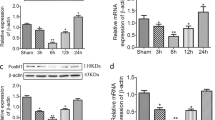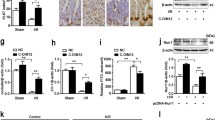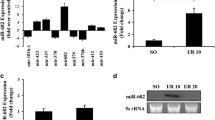Abstract
Intestinal ischemia/reperfusion (I/R) injury is a potentially life-threatening condition that can cause injuries to remote organs at the end stage. The damage caused by intestinal I/R insult induces changes in the barrier functions of the intestine, and the intrinsic mechanism of regeneration is often insufficient to restore barrier functions, as indicated by the high mortality rate of patients experiencing intestinal I/R injury. However, little is known about the mechanisms of intestinal regeneration after I/R injury. Here, we reported that nuclear receptor-related protein 1 (Nurr1), a nuclear orphan receptor, was induced during intestinal regeneration after I/R. Our findings showed that Nurr1 expression was consistent with the expression of Ki-67 and phosphorylated histone H3 (pH 3) in the intestine after I/R injury. Nurr1 knockdown led to G1-phase arrest mediated by p21 (Waf1/Cip1) activation, but Nurr1 overexpression reduced the proportion of IEC-6 cells in G1 phase as a result of p21 inhibition in a p53-independent manner. Using chromatin immunoprecipitation assays, luciferase assays, and mutational analysis, we demonstrated that Nurr1 directly inhibited the transcription of p21. These results define a novel Nurr1/p21 pathway that is involved in intestinal regeneration after I/R injury. These findings provide novel molecular insights into the pathogenesis of intestinal regeneration after I/R and possibly support the development of new potential therapies for intestinal I/R injury.
Key message
-
Nurr1 was induced during intestinal regeneration after I/R injury.
-
Nurr1 promoted proliferation of intestinal epithelial cells after H/R injury.
-
Nurr1 inhibited p21 expression in a p53-independent manner.
-
Nurr1 inhibited p21 gene transcription by binding to p21 promoter directly.







Similar content being viewed by others
References
Grootjans J, Hodin CM, de Haan JJ, Derikx JP, Rouschop KM, Verheyen FK, van Dam RM, Dejong CH, Buurman WA, Lenaerts K (2011) Level of activation of the unfolded protein response correlates with Paneth cell apoptosis in human small intestine exposed to ischemia/reperfusion. Gastroenterology 140:529–539
Karhausen J, Qing M, Gibson A, Moeser AJ, Griefingholt H, Hale LP, Abraham SN, Mackensen GB (2013) Intestinal mast cells mediate gut injury and systemic inflammation in a rat model of deep hypothermic circulatory arrest. Crit Care Med 41:e200–e210
Snippert HJ, van Es JH, van den Born M, Begthel H, Stange DE, Barker N, Clevers H (2009) Prominin-1/CD133 marks stem cells and early progenitors in mouse small intestine. Gastroenterology 136:2187–2194
Hart ML, Grenz A, Gorzolla IC, Schittenhelm J, Dalton JH, Eltzschig HK (2011) Hypoxia-inducible factor-1α-dependent protection from intestinal ischemia/ reperfusion injury involves ecto-5′-nucleotidase (CD73) and the A2B adenosine receptor. J Immunol 186:4367–4374
Sedhom MA, Pichery M, Murdoch JR, Foligné B, Ortega N, Normand S, Mertz K, Sanmugalingam D, Brault L, Grandjean T, et al. (2013) Neutralisation of the interleukin-33/ST2 pathway ameliorates experimental colitis through enhancement of mucosal healing in mice. Gut 62:1714–1723
Liu L, Rao JN, Zou T, Xiao L, Smith A, Zhuang R, Turner DJ, Wang JY (2012) Activation of Wnt3a signaling stimulates intestinal epithelial repair by promoting c-Myc-regulated gene expression. Am J Physiol Cell Physiol 302:C277–C285
Park JS, Yang HN, Woo DG, Jeon SY, Do HJ, Huh SH, Kim NH, Kim JH, Park KH (2012) Exogenous Nurr1 gene expression in electrically-stimulated human MSCs and the induction of neurogenesis. Biomaterials 33:7300–7308
L’Episcopo F, Tirolo C, Testa N, Caniglia S, Morale MC, Serapide MF, Pluchino S, Marchetti B (2014) Wnt/β-catenin signaling is required to rescue midbrain dopaminergic progenitors and promote neurorepair in ageing mouse model of Parkinson’s disease. Stem Cells 32:2147–2163
Ohkubo T, Sugawara Y, Sasaki K, Maruyama K, Ohkura N, Makuuchi M (2002) Early induction of nerve growth factor-induced genes after liver resection-reperfusion injury. J Hepatol 36:210–217
Myers SA, Eriksson N, Burow R, Wang SC, Muscat GE (2009) Beta-adrenergic signaling regulates NR4A nuclear receptor and metabolic gene expression in multiple tissues. Mol Cell Endocrinol 309:101–108
Harper JW, Adami GR, Wei N, Keyomarsi K, Elledge SJ (1993) The p21 Cdk-interacting protein Cip1 is a potent inhibitor of G1 cyclin-dependent kinases. Cell 75:805–816
el-Deiry WS, Tokino T, Velculescu VE, Levy DB, Parsons R, Trent JM, Lin D, Mercer WE, Kinzler KW, Vogelstein B (1993) WAF1, a potential mediator of p53 tumor suppression. Cell 75:817–825
Harper JW, Elledge SJ, Keyomarsi K, Dynlacht B, Tsai LH, Zhang P, Dobrowolski S, Bai C, Connell-Crowley L, Swindell E (1995) Inhibition of cyclin-dependent kinases by p21. Mol Biol Cell 6:387–400
Basu N, Saha S, Khan I, Ramachandra SG, Visweswariah SS (2014) Intestinal cell proliferation and senescence are regulated by receptor guanylyl cyclase C and p21. J Biol Chem 289:581–593
He Y, Zhang X, Zeng X, Huang Y, Wei JA, Han L, Li CX, Zhang GW (2012) HuR-mediated posttranscriptional regulation of p21 is involved in the effect of Glycyrrhiza uralensis licorice aqueous extract on polyamine-depleted intestinal crypt cells proliferation. J Nutr Biochem 23:1285–1293
Kawai H, Wiederschain D, Kitao H, Stuart J, Tsai KK, Yuan ZM (2003) DNA damage-induced MDMX degradation is mediated by MDM2. J Biol Chem 278:45946–45953
Herman AG, Hayano M, Poyurovsky MV, Shimada K, Skouta R, Prives C, Stockwell BR (2011) Discovery of Mdm2-MdmX E3 ligase inhibitors using a cell-based ubiquitination assay. Cancer Discov 1:312–325
Phalke S, Mzoughi S, Bezzi M, Jennifer N, Mok WC, Low DH, Thike AA, Kuznetsov VA, Tan PH, Voorhoeve PM, et al. (2012) p53-independent regulation of p21Waf1/Cip1 expression and senescence by PRMT6. Nucleic Acids Res 40:9534–9542
Wang Y, Gu X, Zhang G, Wang L, Wang T, Zhao Y, Zhang X, Zhou Y, Kadin M, Tu P (2014) SATB1 overexpression promotes malignant T-cell proliferation in cutaneous CD30+ lymphoproliferative disease by repressing p21. Blood 123:3452–3461
Carreira S, Goodall J, Aksan I, La Rocca SA, Galibert MD, Denat L, Larue L, Goding CR (2005) Mitf cooperates with Rb1 and activates p21Cip1 expression to regulate cell cycle progression. Nature 433:764–769
Sousa KM, Mira H, Hall AC, Jansson-Sjöstrand L, Kusakabe M, Arenas E (2007) Microarray analyses support a role for Nurr1 in resistance to oxidative stress and neuronal differentiation in neural stem cells. Stem Cells 25:511–519
Megison SM, Horton JW, Chao H, Walker PB (1990) A new model for intestinal ischemia in the rat. J Surg Res 49:168–173
Leibowitz BJ, Wei L, Zhang L, Ping X, Epperly M, Greenberger J, Cheng T, Yu J (2014) Ionizing irradiation induces acute haematopoietic syndrome and gastrointestinal syndrome independently in mice. Nat Commun 5:3494
Wilson TE, Fahrner TJ, Johnston M, Milbrandt J (1991) Identification of the DNA binding site for NGFI-B by genetic selection in yeast. Science 252:1296–1300
Sandelin A, Wasserman WW, Lenhard B (2004) ConSite: web-based prediction of regulatory elements using cross-species comparison. Nucleic Acids Res 32:W249–W252
Wasserman WW, Sandelin A (2004) Applied bioinformatics for the identification of regulatory elements. Nat Rev Genet 5:276–287
Cartharius K, Frech K, Grote K, Klocke B, Haltmeier M, Klingenhoff A, Frisch M, Bayerlein M, Werner T (2005) MatInspector and beyond: promoter analysis based on transcription factor binding sites. Bioinformatics 21:2933–2942
Blikslager AT, Moeser AJ, Gookin JL, Jones SL, Odle J (2007) Restoration of barrier function in injured intestinal mucosa. Physiol Rev 87:545–564
Grootjans J, Thuijls G, Derikx JP, van Dam RM, Dejong CH, Buurman WA (2011) Rapid lamina propria retraction and zipper-like constriction of the epithelium preserves the epithelial lining in human small intestine exposed to ischaemia-reperfusion. J Pathol 224:411–419
El-Assal ON, Besner GE (2005) HB-EGF enhances restitution after intestinal ischemia/reperfusion via PI3K/Akt and MEK/ERK1/2 activation. Gastroenterology 129:609–625
Ren F, Shi Q, Chen Y, Jiang A, Ip YT, Jiang H, Jiang J (2013) Drosophila Myc integrates multiple signaling pathways to regulate intestinal stem cell proliferation during midgut regeneration. Cell Res 23:1133–1146
Macho-Fernandez E, Koroleva EP, Spencer CM, Tighe M, Torrado E, Cooper AM, Fu YX, Tumanov AV (2015) Lymphotoxin beta receptor signaling limits mucosal damage through driving IL-23 production by epithelial cells. Mucosal Immunol 8:403–413
Taniguchi K, Wu LW, Grivennikov SI, de Jong PR, Lian I, Yu FX, Wang K, Ho SB, Boland BS, Chang JT, et al. (2015) A gp130-Src-YAP module links inflammation to epithelial regeneration. Nature 519:57–62
Sparkes BL, Slone EE, Roth M, Welti R, Fleming SD (2010) Intestinal lipid alterations occur prior to antibody-induced prostaglandin E2 production in a mouse model of ischemia/reperfusion. Biochim Biophys Acta 1801:517–525
Holla VR, Mann JR, Shi Q, DuBois RN (2006) Prostaglandin E2 regulates the nuclear receptor NR4A2 in colorectal cancer. J Biol Chem 281:2676–2682
Ralph JA, McEvoy AN, Kane D, Bresnihan B, FitzGerald O, Murphy EP (2005) Modulation of orphan nuclear receptor NURR1 expression by methotrexate in human inflammatory joint disease involves adenosine A2A receptor-mediated responses. J Immunol 175:555–565
Shi J, Shao W, Yang D, Zhao L, Deng L, Wang X, Sun B (2010) Hydrodynamics-based transfection of plasmid encoding receptor activator for nuclear factor kappa B-Fc protects against hepatic ischemia/reperfusion injury in mice. Liver Transpl 16:611–620
Qi L, Yuan B, Fu Q (2014) Hypoxia/reoxygenation and lipopolysaccharide induced nuclear factor-ΚB and hypoxia-inducible factor-1α signaling pathways in intestinal epithelial cell injury and the interventional effect of emodin. Zhonghua Wei Zhong Bing Ji Jiu Yi Xue 26:409–414
Vacca M, Murzilli S, Salvatore L, Di Tullio G, D’Orazio A, Lo Sasso G, Graziano G, Pinzani M, Chieppa M, Mariani-Costantini R, et al. (2013) Neuron-derived orphan receptor 1 promotes proliferation of quiescent hepatocytes. Gastroenterology 144:1518–1529
Suzuki S, Suzuki N, Mirtsos C, Horacek T, Lye E, Noh SK, Ho A, Bouchard D, Mak TW, Yeh WC (2003) Nur77 as a survival factor in tumor necrosis factor signaling. Proc Natl Acad Sci U S A 100:8276–8280
Qiu J, Takagi Y, Harada J, Rodrigues N, Moskowitz MA, Scadden DT, Cheng T (2004) Regenerative response in ischemic brain restricted by p21cip1/waf1. J Exp Med 199:937–945
Dulić V, Kaufmann WK, Wilson SJ, Tlsty TD, Lees E, Harper JW, Elledge SJ, Reed SI (1994) p53-dependent inhibition of cyclin-dependent kinase activities in human fibroblasts during radiation-induced G1 arrest. Cell 76:1013–1023
Enge M, Bao W, Hedström E, Jackson SP, Moumen A, Selivanova G (2009) MDM2-dependent downregulation of p21 and hnRNP K provides a switch between apoptosis and growth arrest induced by pharmacologically activated p53. Cancer Cell 15:171–183
Eipel C, Schuett H, Glawe C, Bordel R, Menger MD, Vollmar B (2005) Pifithrin-alpha induced p53 inhibition does not affect liver regeneration after partial hepatectomy in mice. J Hepatol 43:829–835
Wu B, Qiu W, Wang P, Yu H, Cheng T, Zambetti GP, Zhang L, Yu J (2007) p53 independent induction of PUMA mediates intestinal apoptosis in response to ischaemia-reperfusion. Gut 56:645–654
Merritt AJ, Allen TD, Potten CS, Hickman JA (1997) Apoptosis in small intestinal epithelial from p53-null mice: evidence for a delayed, p53-independent G2/M-associated cell death after gamma-irradiation. Oncogene 14:2759–2766
Wang Z, Benoit G, Liu J, Prasad S, Aarnisalo P, Liu X, Xu H, Walker NP, Perlmann T (2003) Structure and function of Nurr1 identifies a class of ligand-independent nuclear receptors. Nature 423:555–560
Cho SD, Lee SO, Chintharlapalli S, Abdelrahim M, Khan S, Yoon K, Kamat AM, Safe S (2010) Activation of nerve growth factor-induced B alpha by methylene-substituted diindolylmethanes in bladder cancer cells induces apoptosis and inhibits tumor growth. Mol Pharmacol 77:396–404
Yu S, Wong YC, Wang XH, Ling MT, Ng CF, Chen S, Chan FL (2008) Orphan nuclear receptor estrogen-related receptor-beta suppresses in vitro and in vivo growth of prostate cancer cells via p21 (WAF1/CIP1) induction and as a potential therapeutic target in prostate cancer. Oncogene 27:3313–3328
Byun JK, Choi YK, Kang YN, Jang BK, Kang KJ, Jeon YH, Lee HW, Jeon JH, Koo SH, Jeong WI, et al. (2015) Retinoic acid-related orphan receptor alpha reprograms glucose metabolism in glutamine-deficient hepatoma cells. Hepatology 61:953–964
Acknowledgments
This work was supported by grants from the National Natural Science Foundation of China (No. 81372037, No. 81671954) and the Natural Science Foundation of Liaoning Province, China (No. 201102048).
Author information
Authors and Affiliations
Corresponding author
Ethics declarations
Conflict of interest
The authors declare no conflicts of interest.
Electronic supplementary material
ESM 1
(PDF 180 kb)
Rights and permissions
About this article
Cite this article
Zu, G., Yao, J., Ji, A. et al. Nurr1 promotes intestinal regeneration after ischemia/reperfusion injury by inhibiting the expression of p21 (Waf1/Cip1). J Mol Med 95, 83–95 (2017). https://doi.org/10.1007/s00109-016-1464-6
Received:
Revised:
Accepted:
Published:
Issue Date:
DOI: https://doi.org/10.1007/s00109-016-1464-6




